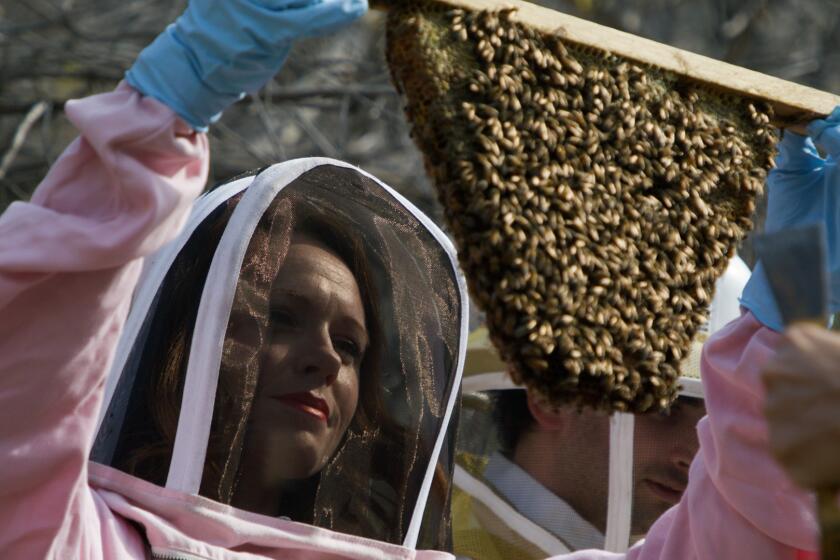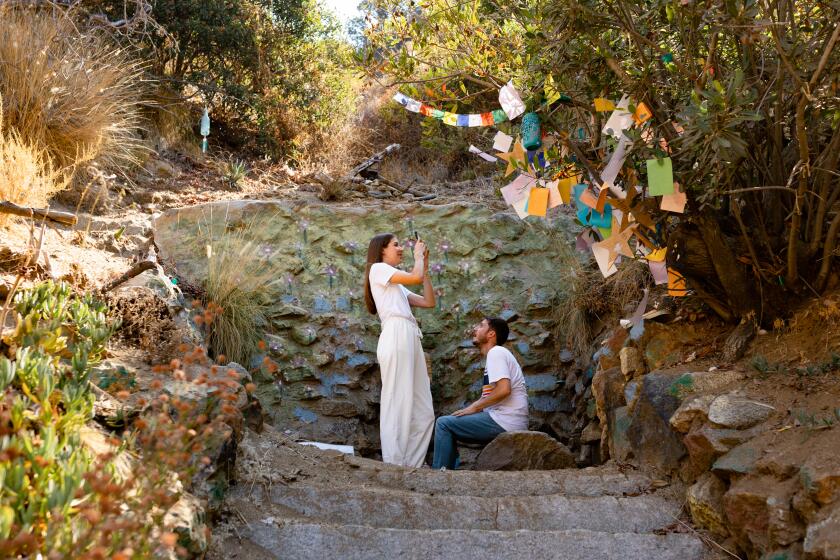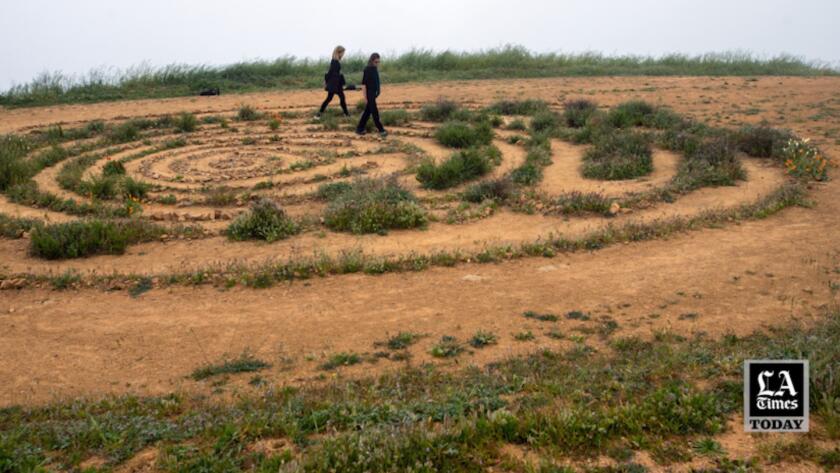Feeling lost? L.A.’s labyrinths can help you return to center
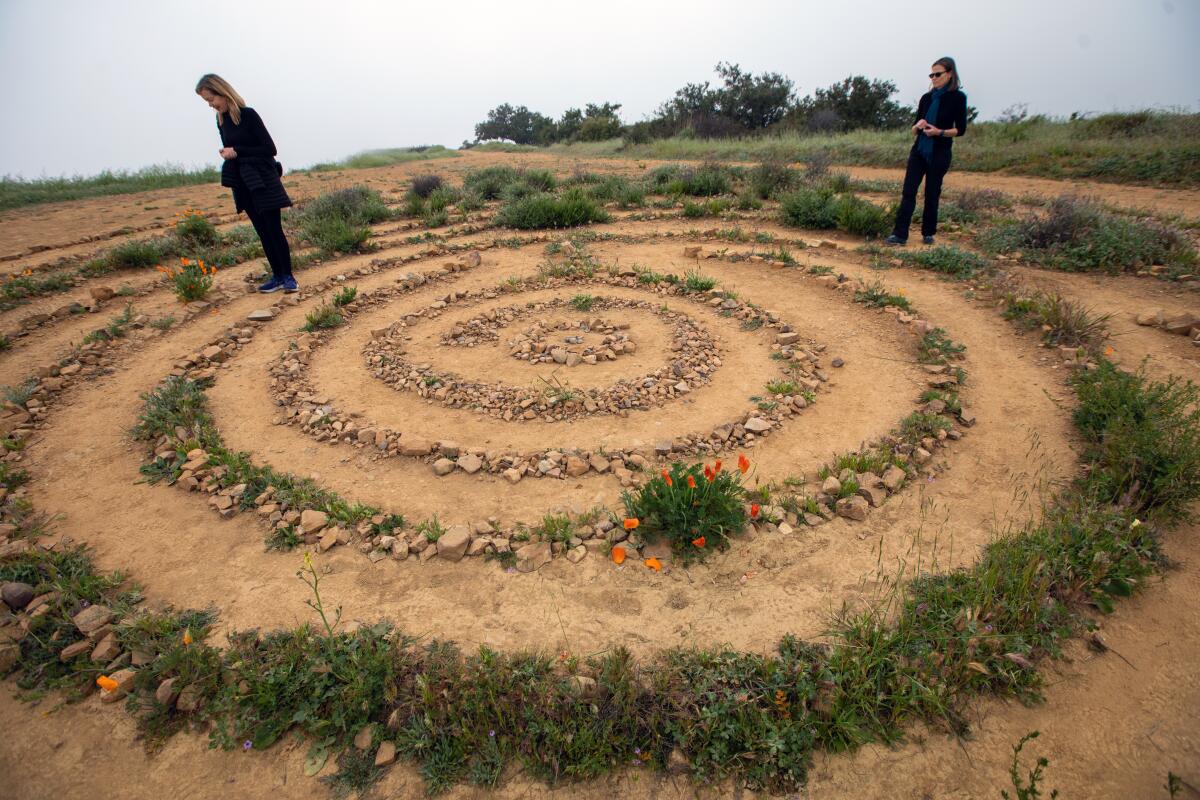
- Share via
Katie Bull is hiking up a dirt trail in Tuna Canyon to a destination that doesn’t appear on any map, a secret labyrinth.
It’s high in the Santa Monica Mountains with a view out to the Pacific. The 62-year-old Encino resident has dubbed it “the Crown of Los Angeles.”
She assures her hiking companions that it’s not too far now, then she spots it — a twisting circular pattern made of stones, arranged by an unknown maker, an anonymous gift to L.A.
Bull and her friend Dana Bain take in the view. The mist obscures the ocean and covers the mountains in a thin, gauzy haze. They admire the orange, purple and yellow of the wildflowers, now fully in bloom.
Then they begin.
Bull strikes a bell, and they each set an intention — Bull for her husband, Bain for her immediate family.
Bull bows at the entrance of the labyrinth and then, slowly, begins to walk.
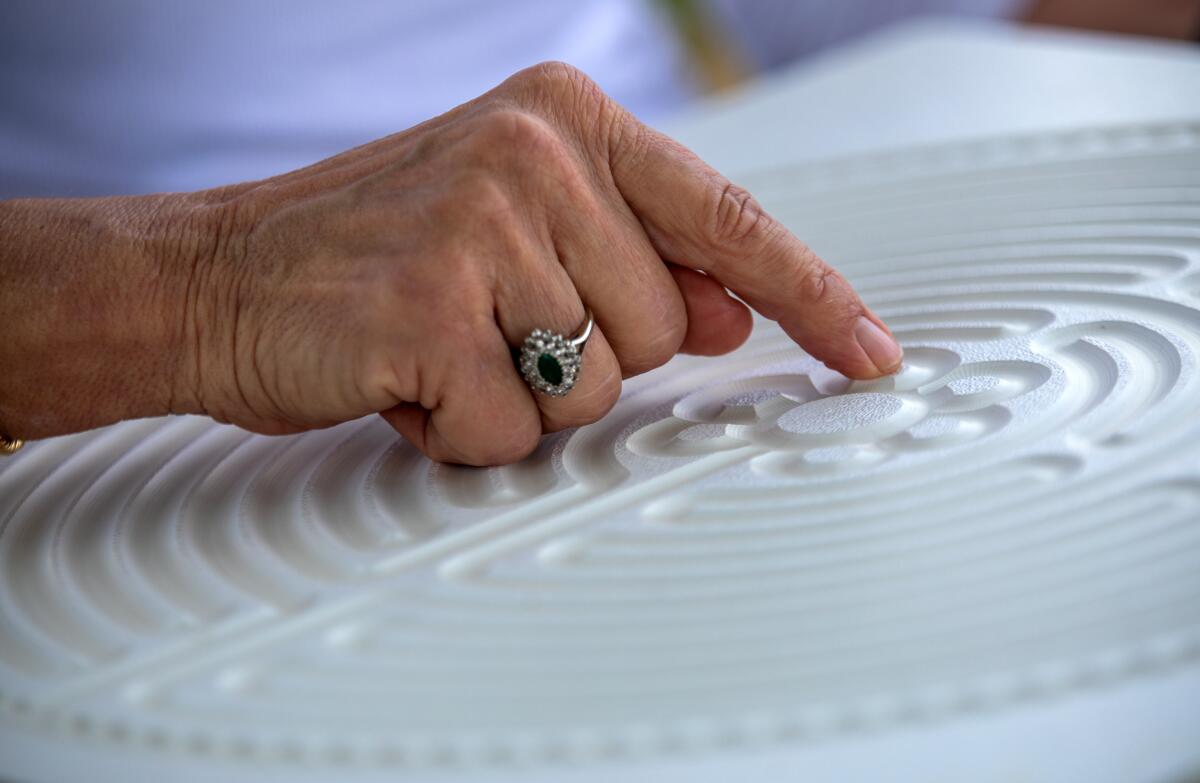
Thin and earnest with a touch of a Southern accent hinting at her Louisiana roots, Bull is a longtime spiritual seeker who has been walking labyrinths for decades. But it wasn’t until the COVID-19 pandemic that she came out to her community as a devoted labyrinth lover.
“It was deeply important to me, and it had been a part of my life for a very long time,” she said. “But I was sort of closed up about it. It never occurred to me to share it.”
Then the pandemic turned the world upside down, and the weekly parent mindfulness group she’d long led at Campbell Hall, a private school in Studio City, became a lifeline for its members. At one of the group’s online meetings, she hesitantly offered up walking labyrinths as a potential tool for healing and connection.
“I almost whispered it,” she recalled. “I said, ‘I do this thing called labyrinths.’ And it felt like the whole Zoom screen just leaned in and said, ‘What’s that?’”
Labyrinths and mazes are often confused, but they’re not the same. A maze is a puzzle — false turns and dead ends are built into the design.
A labyrinth, on the other hand, offers a single path, circuitous and indirect, that leads the walker to center, and then out again.
You cannot get lost in a labyrinth as long as you follow the path. Perhaps, then, it is no surprise that in a time when so many people feel they have lost their way, interest in labyrinths has soared.
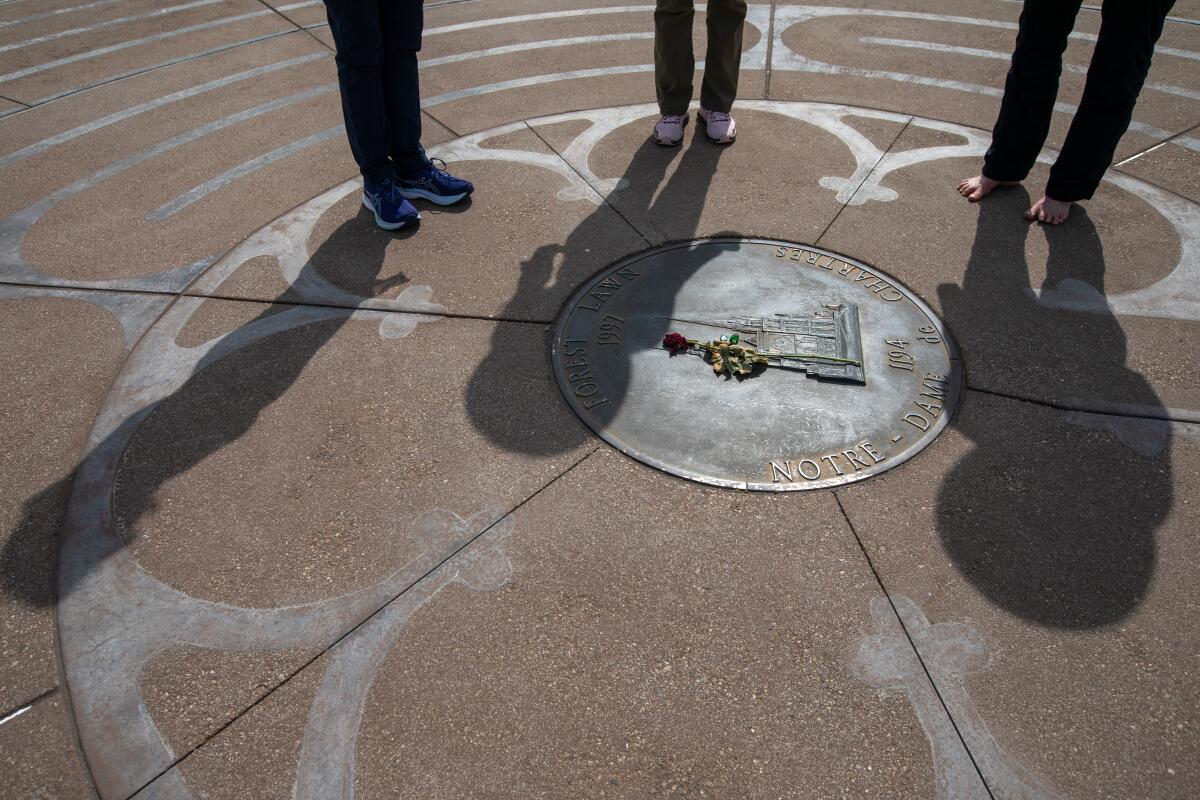
“It’s exactly what we all need right now,” Bull said. “It’s a tool that helps us slow down, reflect, and find our way back to center.”
Indoor labyrinths in churches and cathedrals had to close at the start of the pandemic, but outdoor labyrinths such as the Crown offered a COVID-safe way for people to gather in meditation and community.
As the pandemic continued, Bull became a certified labyrinth facilitator through Veriditas, an organization whose mission is to connect people to labyrinths. She created a Facebook page of labyrinths in the Los Angeles region.
Marvin Jordana is among a small but growing handful of beekeepers who see their work as a spiritual practice, communing with bees as an encounter with an ancient wisdom.
This year she is also heading the city’s planning committee for World Labyrinth Day, an annual international event sponsored by the Labyrinth Society and Veriditas. The celebration encourages churches, retreat centers, hospitals and other institutions to open their labyrinths to the public on the first Saturday of May.
“Last year we had one site participating, and there are at least 11 that have registered this year,” Bull said. “That just shows you how much this has blown up.”
::
Bull never rushes through a labyrinth.
On this gray Wednesday morning, she pauses at a turn and gazes out toward the ocean. A few moments later she is bending over a California poppy that has sprouted between the stones. In her hand she holds a small rock she found on the ground, a touchstone that can be helpful for focus. When she arrives at the labyrinth’s center, she places it down.
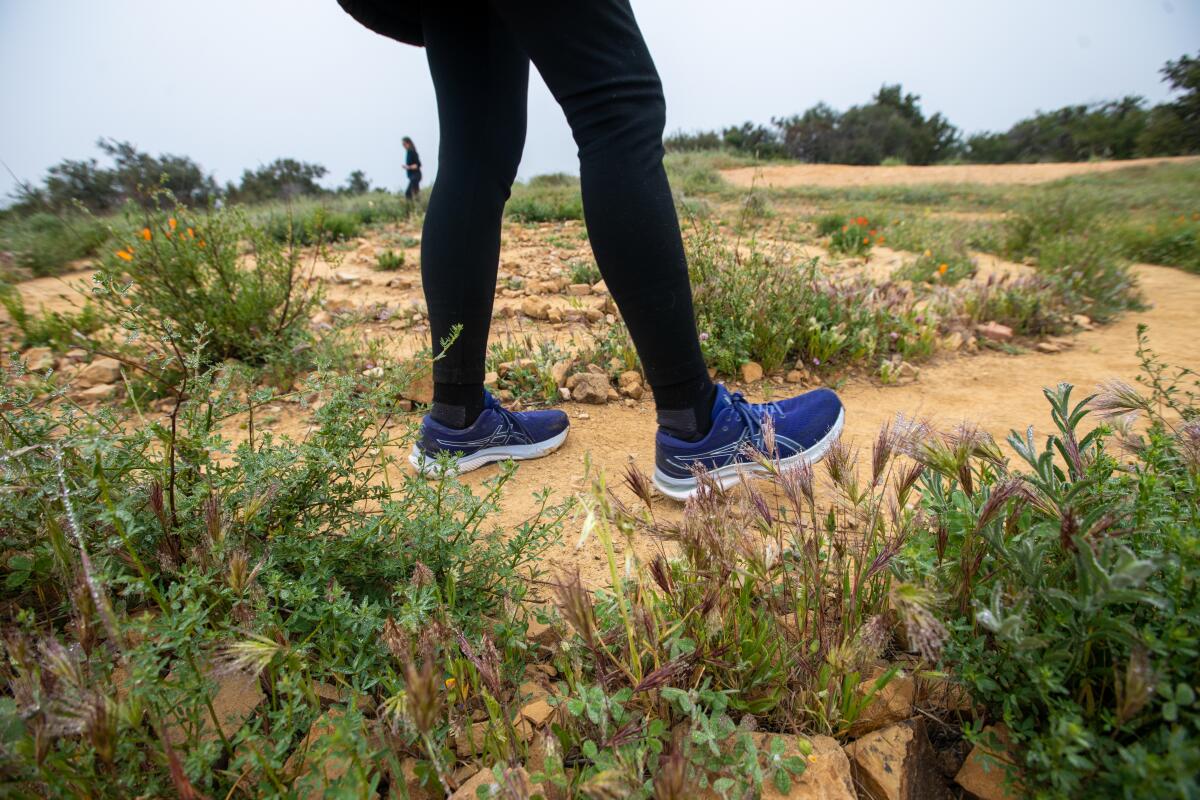
Walking a labyrinth is a form of walking meditation, similar to what you might find in some Buddhist traditions, said Michael O’Palco, a retired Catholic school teacher who leads labyrinth walks at Holy Spirit Retreat Center in Encino.
“You can think of it as a pilgrimage,” he said.
Metaphors abound. Walking to the center of a labyrinth can represent the journey to the center of our being, while its single path has been interpreted as the creation of order from chaos.
Some say the labyrinth represents the birth canal, the shape and complexity of the brain, or the turns of the intestines, helping the walker to digest whatever might be going on in his or her life.
Chantel Zimmerman, a certified labyrinth facilitator who leads creative and spiritual workshops and retreats through her company, Art and Soul Lab, said some people call the opening of the labyrinth “the mouth” because “the labyrinth has something to tell you.”
Kathleen Kinmont is a yoga teacher and member of the Campbell Hall mindfulness group who has done several labyrinth walks with Bull at the Forest Lawn Memorial Park in Glendale. She says a labyrinth walk is akin to a “medieval reboot.”
“You know when you hit that little refresh button on your computer screen and everything gets brighter?” she asked. “Just knowing there is only one way in and one way out allows you to relax.”
Bain likened it to taking a spiritual shower. “It’s like when your mind is spinning on all these things, and then in the shower you have this epiphany — that moment of clarity,” she said. “I feel like it leads to that feeling of clearing that spinning part of your brain.”
Although there is no single way to walk a labyrinth, Bull invites the groups she leads to focus on the “Four Rs”: Remembering why you’re here, Releasing on the walk toward the center, pausing to Receive in the center, and, finally, thinking about the idea of Return on the way out.
“What are you taking from all that you let go, from what you received? What are you returning to the world to do with it?” she said. “Are you going to apologize to someone? Are you going to take an online course or go on that trip? Are you going to cry?”
Feeling sad or hopeless ? These 12 beautiful places in Los Angeles will lift your spirits.
After exiting the labyrinth, she encourages people to journal about their experience, and if they are comfortable, to share with the group.
Not every walk will be transformative, said O’Palco, but they are almost always helpful. “I always say, ‘I wish that I could promise that God will whisper in your ear.’ But I can’t promise that,” he said.
“What I can promise is that if you walk it with a sincere heart, you will leave with a lot of peace.”
::
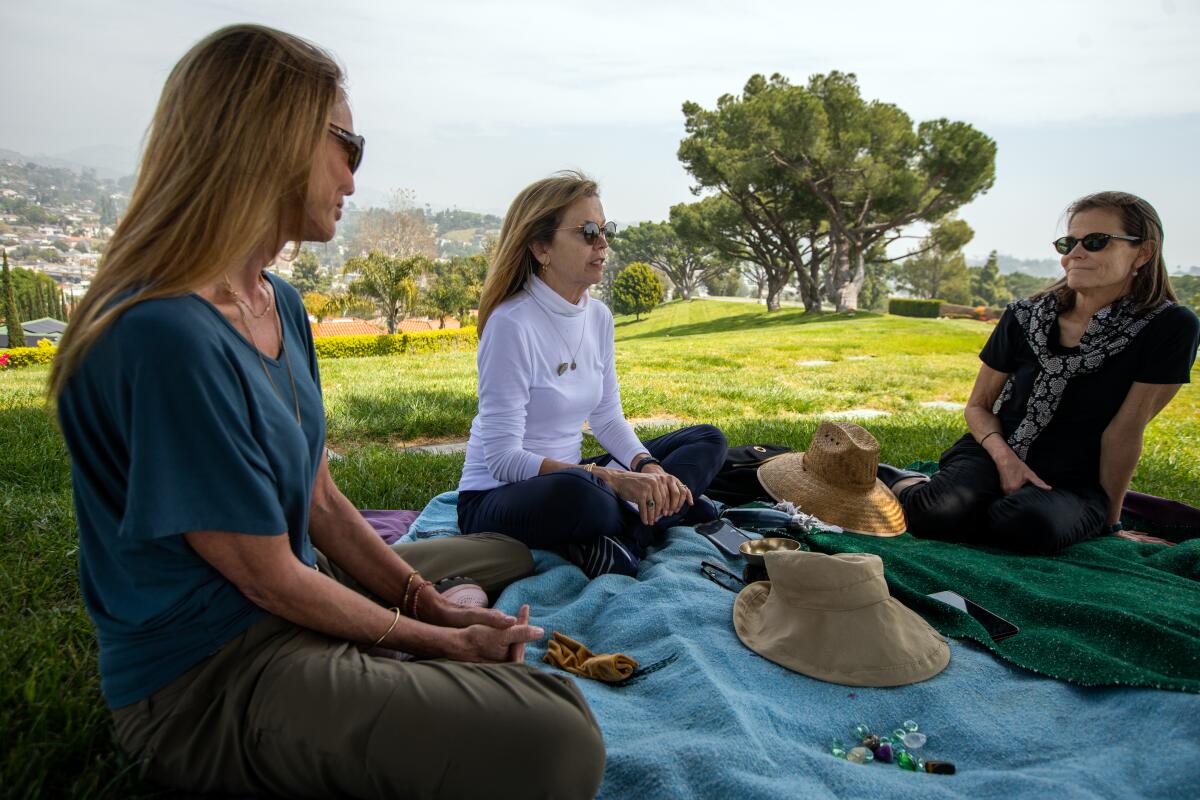
Labyrinths may feel like a new age phenomena — similar to crystals and tarot cards — but some of the oldest known walkable labyrinths on the planet were built in medieval cathedrals.
“This isn’t a new age thing, it’s a medieval age thing,” said Lauren Artress, canon emeritus at Grace Cathedral Church in San Francisco, and the woman credited with bringing walkable labyrinths to the United States. Still, when she started popularizing labyrinths in the early ’90s, she remembers encountering resistance from some Christian institutions.
“It seemed weird to pray when you’re walking,” she said. “But it is in the Christian tradition. It’s in every tradition. It’s archetypal and universal.”
Bull remembers a conversation she had decades ago with a volunteer at a rummage sale at an Episcopal church in New Orleans where she was helping the church raise funds to build a labyrinth. The volunteer wanted to know if Jesus Christ would support the labyrinth.
“I didn’t hesitate,” Bull said. “I was like: ‘Absolutely. Jesus would be all about anybody going within and speaking with Him and seeking insight. It’s just a different way.’”
Most of the L.A. labyrinths participating in World Labyrinth Day can be found at Christian churches and retreat centers including Prince of Peace Episcopal Church in Woodland Hills, First United Methodist Church in Santa Monica, the Mary & Joseph Retreat Center in Palos Verdes, All Saints Church in Simi Valley and St. Kateri Tekakwitha Catholic Church in Santa Clarita.
Father Rand Reasoner of Prince of Peace Episcopal Church, where Zimmerman will lead a free labyrinth walk at 8:30 a.m. Saturday, said the labyrinth on the church’s property is used by a variety of people in and out of the church.
“We’ve had mothers groups use it, school groups have come, people in the neighborhood, people in the church,” he said. “Some of them I’m sure are Christians and some of them I’m sure are not — and that I think is the beauty of this tool.”
Some labyrinths don’t require walking at all. Finger labyrinths are handheld and allow the user to trace the path with their finger to induce a meditative state.
In the early days of the pandemic, when even outdoor labyrinths felt risky, Veriditas started offering free, weekly guided finger labyrinth walks on Fridays over Zoom. It was so popular that three years later, they’re still doing it.
Labyrinths appeal to people across a wide range of belief systems, Artress said.
“You can be religious and say I’m walking with God, you can be metaphysical and new age and say I’m walking with source, or you can be scientific and say I’m walking to be meditative and induce the relaxation response,” she said.
Bull says walking quadrant after quadrant of a labyrinth balances the brain. “I am here to tell you, it works,” she said.
::
After slowly making her way to the labyrinth’s exit, Bull stops just before stepping out. She closes her eyes and puts her hands over her heart. Her expression is serene.
Bull has seen people work through dreams that had puzzled them in the container of the labyrinth. Others have gone to the labyrinth to grieve, sometimes walking with a scarf over their heads so they can’t see or be seen. Still others have worked on determining their life path.
“They’re great for marking celebrations such as major birthdays or New Year’s Eve, or to honor Mother’s and Father’s Day or to mark a major life transition, weddings,” she said. “A great amount of stress gets lifted, dreams and problems get solved. Tears are shed.”
In Louisiana, Bull had lots of friends who loved labyrinths; her sister is a labyrinth facilitator too. When she moved to L.A. 20 years ago, she was surprised to find there was no similar community here. Now, with so many people feeling lost and bereft, she is hoping to help create it.
“It’s a mystery that there wasn’t more of a community because there are labyrinths here,” she said. “They just don’t have someone helping them to reemerge. That’s kind of what World Labyrinth Day in L.A. is about, to help get more contemplative places to the citizens of Los Angeles.”
Back at the Crown, Bull’s labyrinth walk is done. She gives the arrangement of stones and wildflowers a farewell glance.
Then she begins the hike back to her car, stronger, clearer and more centered after having walked, once again, the labyrinth’s winding path.
- Share via
Watch L.A. Times Today at 7 p.m. on Spectrum News 1 on Channel 1 or live stream on the Spectrum News App. Palos Verdes Peninsula and Orange County viewers can watch on Cox Systems on channel 99.
More to Read
Sign up for Essential California
The most important California stories and recommendations in your inbox every morning.
You may occasionally receive promotional content from the Los Angeles Times.
